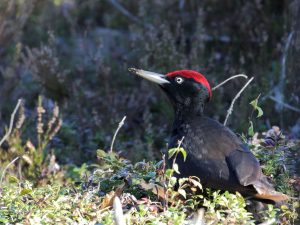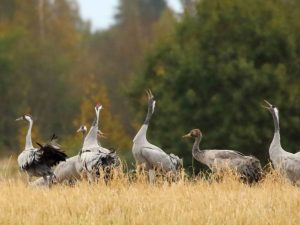
easy spring birding on the Baltic coast
A week on the Baltic, in search of owls, woodpeckers, grouse and sea ducks.
Download leaflet
Dates
To be confirmed
Leader
To be confirmed
Price
To be confirmed
Included
Return flight London Heathrow to Tallinn. Local transport as specified in itinerary. Seven nights accommodation, full board.
Not included
Refreshments. Gratuities. Travel insurance. ETIAS/visa costs. Covid tests and associated costs.
Group size
Minimum 5, maximum 14
April in Estonia is a busy time in the bird watching calendar. Wintering birds are preparing for their return to the Arctic, while local forest residents gear up for a busy breeding season. Meanwhile, from the south, the first of the summer migrants are already arriving, with Lesser Spotted Eagle, Golden Plover, Slavonian and Red-necked Grebes, and large flocks of colourful Ruff all amongst the migrants we may expect to come across.
Over the winter, Estonian waters host large flocks of sea duck, with thousands of Long-tailed Duck, Common and Velvet Scoters and Greater Scaup joined by about 500 Steller’s Eider. In early spring, they come closer to shore and are easier to see here, the most reliable place in Europe to find this rare Arctic species, just before they head north again for the breeding season.
Meanwhile, in the forests, woodpeckers, owls and forest grouse are becoming more active as they set up their breeding territories. The lekking period for Capercaillie, Black Grouse and Hazel Grouse is just getting in to full swing, while Ural, Pygmy and Tengmalm’s Owls have started to declare their territories, and seven species of woodpecker are drumming amongst the trees.
This ‘easy birding’ itinerary is designed to give us our best chance of catching up with these exciting species of the forest and coast, at a relaxed and comfortable pace.
We have been visiting Estonia in the company of our friends at NatourEst since 2014, and this will be our tenth visit to this friendly Baltic country.
Please note that holidays change, although sometimes only slightly, from year to year and previous trip reports may not reflect the planned itinerary, or other holiday details, for the current trip. Please ask us if you would like to know of any significant differences.
Day 1 Our flight takes us to Tallinn, where we spend our first night. For those who are interested, there may be some time in the evening to explore the medieval streets of the old city centre.
Day 2 We set off for western Estonia and a ferry across to the island of Saaremaa. Along the way we will look out for a late Rough-legged Buzzard or Great Grey Shrike at the roadside. The afternoon will give us our first opportunity to look for sea ducks along the north eastern coast of the island, hopefully including Long-tailed Duck, Smew, Greater Scaup and both Common and Velvet Scoters.
Days 3 and 4 During our time on Saaremaa, we will be hoping to track down Steller’s Eiders. They mainly spend winter along the Aleutian chain and in far eastern Russia, with a small number on the Arctic coast of Finland and down here in the Baltic. For most of the winter they are way out on the edge of the sea ice, only moving closer into shore for a short window as winter turns to spring. Depending on how the winter has been, we might find them straight away, it might take us some time, or they may have already departed for their Arctic breeding grounds: our fingers will be firmly crossed! We will no doubt enjoy the other birdlife of the island. White-tailed Eagles are often seen patrolling the coastline, and Waxwings may turn up in the coastal juniper stands. The forests are a good place to look for Nutcracker and both Common and Parrot Crossbills, while in the evening we will try our luck for both Pygmy Owl and the shy Tengmalm’s Owl.
Day 5 We head back to the mainland, to some time in the Puhtu-Laelatu wooded meadows and Marimetsa forest, with our attention turned to woodpeckers: White-backed, Grey-headed, Three-toed, Middle-spotted and Black Woodpeckers are all present, alongside the more familiar Great Spotted and Lesser Spotted Woodpeckers. In Matsalu National Park, we hope to see big flocks of Barnacle, Tundra Bean and White-fronted Geese gathering ahead of their northwards migration, while on the coastal meadows large numbers of Ruff gather in their showy breeding colours.
Day 6 An early start will give us a chance to look for Capercaillie along the roadside, before we head to an area between two vast peat bogs, where Black Grouse gather to lek. Later in the day, we will return to the forests, with the ghostly Ural Owl our chief target.
Day 7 Today we visit the Põõsaspea Peninsula, one of the best spots in Estonia to observe the migration of Arctic waterfowl, as they make their way back north from the Baltic up to Finland and Arctic Russia: on a good day, tens of thousands of ducks, geese and divers can be seen streaming past the point. The afternoon will be spent at Leidissoo Forest, home to seven woodpecker species, as well as the shy Hazel Grouse: we will keep our ears peeled for the ‘dog whistle’ calls of the males.
Day 8 After breakfast we drive back east, to Tallinn and our flights home.
Please note that the itinerary may be changed to suit the weather or other practicalities at the discretion of the leaders.
The hotels used are of a very good standard and all rooms have en-suite facilities.
Meals provided during the stay will have an emphasis on local cuisine. We will have a mixture of picnic lunches and lunches in local cafes/restaurants.
Transport will be by small bus or smaller vehicles if necessary.
Group flights
Group flights are with Finnair from London Heathrow to Tallinn via Helsinkin.
Overland travel
You can reach Estonia by train from the UK, with some route options also involving a ferry. From London you can reach Tallinn in three to four nights. Contact us to find out more, and to make your holiday flight-free.
Time zone
Estonia is two hours ahead of UK time.
Entry requirements
If you hold a British passport you can travel to the Schengen area (which includes Estonia) for up to 90 days in any 180-day period without a visa. Your passport must be issued less than ten years before the date you enter the country and valid for at least three months after the day you plan to leave.
Starting in 2026 British passport holders will need to apply for the ETIAS European Travel Authorisation to visit Schengen countries. This must be applied for online prior to travel, at a cost of €7 (free for over 70s). Once granted, your ETIAS will be valid for three years.
April is typically a cold but dry month in Estonia: maximum temperatures are likely to be no more than 10°, dropping down to freezing conditions overnight. We may also encounter snow or rain showers, although April is generally a dry month.
On most days, we are out and about for much of the day, albeit walking a relatively slow pace and making several stops each day. It is necessary to walk on rougher ground and up some slopes, although none of the walking is strenuous.
There are steps at our hotels, as well as at tower hides. Some early starts and/or late finishes will be likely, to maximise our chances to see the wildlife.




